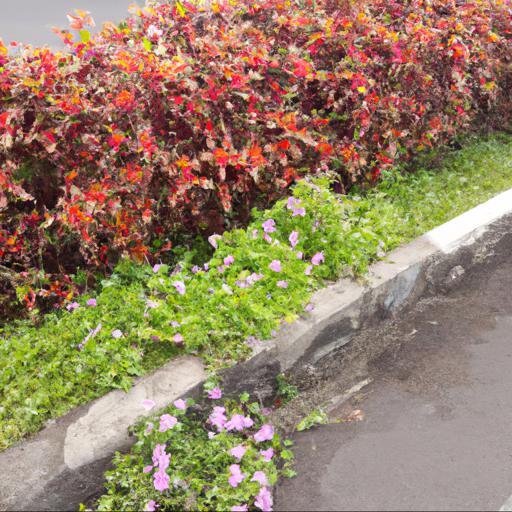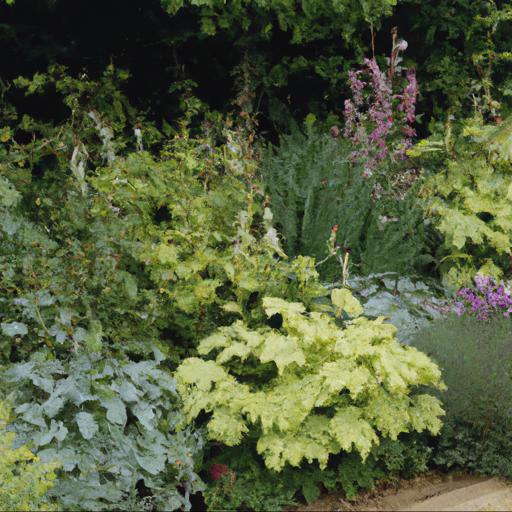Are you looking for plants to add to the middle of your garden border? If so, you’re in luck!
There are a variety of plants that can work for this purpose, from tall, flowering varieties to low-growing, evergreen shrubs. In this blog, we’ll explore the best plants for the middle of a border, so you can create a beautiful, eye-catching landscape in your garden. We’ll discuss the different types of plants available, the benefits of each, and how to care for them.
With the right plants in the middle of your border, you can create a stunning display that will be the envy of your neighbors.
Benefits of planting plants in the middle of a border

Planting plants in the middle of a border can be a great way to create a stunning garden design feature. Plants for the middle of a border can help to bring a garden to life, adding a splash of colour, texture and depth. Not only can it be visually attractive, but it can also be beneficial in so many ways.
One benefit of planting plants in the middle of a border is the increased protection they can provide. Taller plants placed in the center of a border will act as a buffer zone against strong winds, particularly in an exposed area.
This can be especially helpful when you have a collection of delicate plants or shrubs. As an added bonus, the protection can also help to contain weeds and prevent them from infiltrating. Another advantage of planting plants in the middle of a border is the potential for creating more depth and interest in the garden.
A group of plants with different forms and textures placed in the center will act as a focal point and increase visual appeal. Varied heights can also be used to create depth and the perfect backdrop for color and foliage.
Finally, the placement of plants in the middle of a border can also help to create a more natural aesthetic. Introducing native plants and trees will help to establish a stronger link with the local environment and make the garden more inviting.
It will also allow you to create a more diverse and ecologically friendly environment that encourages wildlife. Whether you’re looking for a stunning visual feature or increased protection, planting plants in the middle of a border is an excellent way to achieve your goals. With careful selection and effective placement, it can be an effective and long-lasting solution.
Types of plants suitable for the middle of a border

When planning a garden, one of the biggest decisions is what type of plants to choose for the middle of the border. It is important to select plants that provide the right balance of texture, color, and overall shape.
This is the area where you can really get creative, so when choosing plants for the middle of the border, it pays to consider a selection of annuals, perennials, grasses, and evergreens. Annuals provide a huge variety of colors and are excellent for providing a burst of energy to the middle of the border. Plants such as marigolds, petunias, and zinnias make for an excellent colorful display and have the advantage of growing quickly and blooming during the entire summer.
Annuals can be changed out year to year in order to ensure the colors are always fresh and vibrant. Perennials can add extra depth to the center of the border. Shorter varieties such as Daylilies, Dianthus, and Geraniums are good options and provide a long-lasting display of colorful blooms.
For a taller focal point, look for plant varieties such as Astilbe, Coreopsis, and Peonies. Perennials also have the advantage of coming back year after year once they are established.
Grasses are great for providing texture and a more natural look in the center of the border. Try planting popular grasses such as Maiden Grass, Blue Fescue, or even a variety of ornamental grasses. Grasses can provide an anchor in the middle of the border and when combined with colorful annuals, add a great deal of interest.
Evergreens make an excellent choice for the middle of the border. For a splash of greenery, look for varying heights of Junipers or Boxwoods and in larger spaces, Arborvitaes or Rose of Sharons make for a stunning addition.
Evergreens offer a great deal of year-round color and will provide a backdrop for the other plants in the border. When selecting what type of plants to put in the middle of the border, take into consideration size, texture, color, and season of interest. Plants should always be chosen based on what works best at that particular location. Ultimately, creating the perfect border is all about experimentation and having fun.
Tips for planting and caring for plants in the middle of a border

When selecting plants for the middle of a border, there is often a need to consider many factors. It is important to ensure that the height and texture of the chosen plants complement the plants along the border, and that the overall design looks pleasing to the eye. Additionally, it is important to take into account the amount of light, soil type and moisture levels which could influence the condition of the plants.
First, it is recommended to choose plants with differing heights and textures to create interest and an appealing border. Consider both evergreen and deciduous shrubs and plants, as these can provide structure and a variety of seasonal interest to the design.
For example, evergreen shrubs like Rhododendron, Viburnum and Pieris have evergreen foliage and year round interest, while deciduous shrubs like Potentilla, Hebe or Spiraea will bring seasonal colour to the border with their flowers and autumn colour. Secondly, it is important to pay attention to the light levels and consider if they vary across the border area.
Generally, by choosing plants that display different foliage structure and colour, different light levels can be catered for. For instance, plants with large bold leaves like Hydrangea, Calycanthus, Magnolia, and for shade Fatsia, Hydrangea paniculata and Hosta, could add large bold leafy structure to the design. For sunny areas of the border, choose airy plants like Perovskia and Lavandula, which will give the border lightness, and create attractive silhouettes.
Finally, moisture and soil conditions will affect plant health, and should be taken into account while selecting plants. Plants that require extra moisture, such as Lavatera and Verbena, can be placed in damp areas, while those requiring good drainage, such as Sedum and Heuchera, should be placed in dry areas.
In more challenging locations, it is possible to select plants which are more tolerant of both dry and wet soils. Grasses, such as Carex, Molinia, and Festuca can tolerate a variety of conditions, as can hardy perennials, such as Alchemilla mollis and Ajuga reptans, which can spread quickly to fill empty areas. In summary, when selecting plants for the middle of a border, careful consideration must be taken to both size and texture of the chosen plants, and how they interact with the existing plants.
Additionally, it is important to take into account the varying levels of light and moisture, which can impact the health of the plants. With careful selection, it is possible to create an interesting border design which fits the scheme of a garden.
Our video recommendation
Conclusion
This article discussed the best plants to use for the middle of a border. Plants such as Shasta daisies, coneflowers, lavender, and coreopsis were recommended as they are easy to grow and will add texture and color to any garden. Additionally, they are low-maintenance and will provide a beautiful backdrop to any garden.
With a little bit of research and planning, these plants can create a stunning display in any garden.
FAQ
What plants are best suited for the middle of a border?
Some plants that are well suited for the middle of a border are tall ornamental grasses, shrubs, and perennials such as coneflowers, daisies, and black-eyed Susans.
What are the benefits of planting in the middle of a border?
The benefits of planting in the middle of a border include creating a focal point in the garden, providing a sense of depth and dimension to the landscape, and helping to create a sense of unity between the plants and other elements in the garden. Additionally, planting in the middle of a border can help to create a sense of balance and symmetry in the garden.
What are some tips for creating a successful border design?
1. Choose a color palette that complements the overall design. 2. Use a variety of line weights and textures to create visual interest. 3. Consider the purpose of the border and how it will be used. 4. Incorporate geometric shapes and patterns to add depth and texture. 5. Use a consistent style throughout the design. 6. Consider the scale of the design and how it will look when printed. 7. Balance the border with the rest of the design elements.
What are some common mistakes to avoid when planting in the middle of a border?
Common mistakes to avoid when planting in the middle of a border include planting too close to the edge of the border, planting too many plants in the same area, and not taking into account the size of the plants when planning the border. Additionally, it is important to consider the soil type and drainage of the area, as well as the amount of sunlight the plants will receive.
What are some of the most popular plants for the middle of a border?
Some of the most popular plants for the middle of a border include coneflowers, daylilies, coreopsis, phlox, and black-eyed susans.
What are some of the best plants for providing year-round interest in the middle of a border?
Some of the best plants for providing year-round interest in the middle of a border are ornamental grasses, evergreen shrubs, and perennial flowers.

